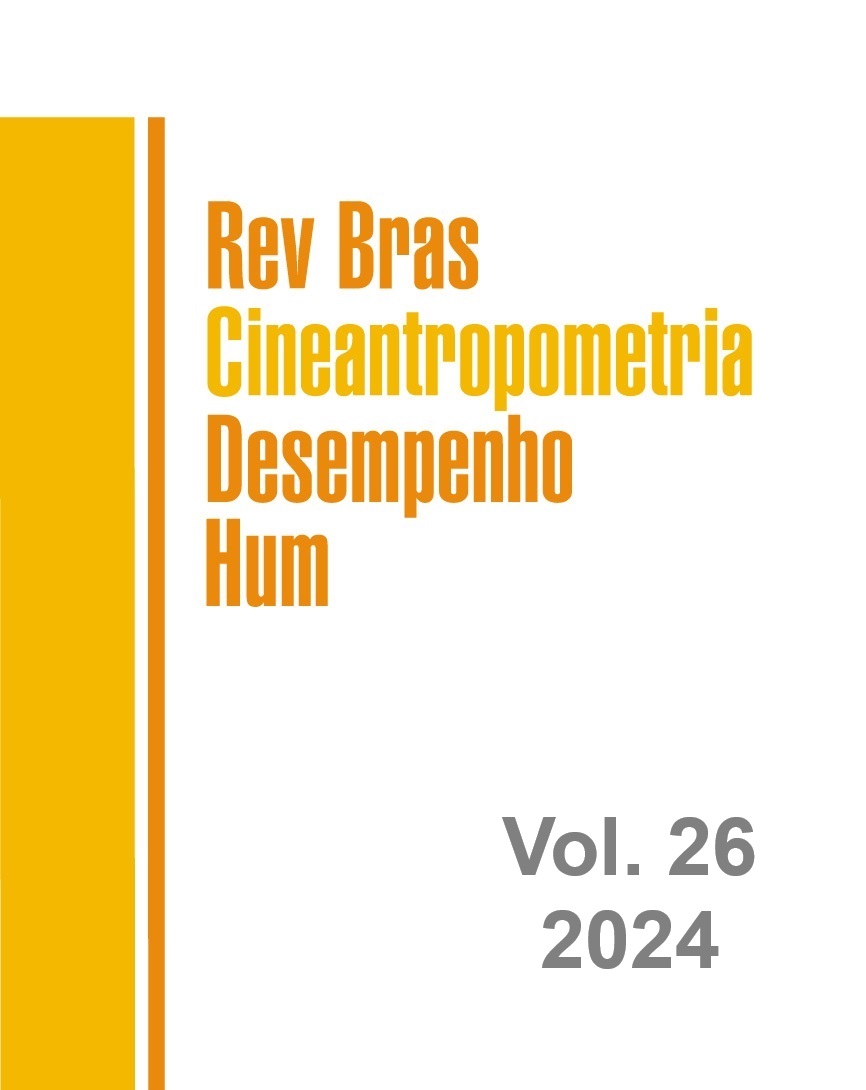Efeito da idade relativa na potência muscular em jovens brasileiros: um estudo de população
DOI:
https://doi.org/10.1590/1980-0037.2024v26e98244Palavras-chave:
Força muscular, Destreza Motora, Teste de aptidão física, Esportes para Jovens, CriançaResumo
Este estudo teve como objetivo examinar o efeito da idade relativa na potência muscular em crianças e adolescentes brasileiros. A amostra foi composta por 87.766 meninas e meninos com idades entre 7 e 16 anos. Os participantes foram agrupados em quatro subgrupos etários dentro de cada idade cronológica tendo como base as datas de nascimento e da coleta dos dados. A potência muscular dos membros superiores e inferiores foi avaliada por meio dos testes de arremesso de medicine ball de 2 kg, e salto horizontal, respectivamente. A distribuição normativa (fraco; razoável; bom; muito bom; excelente) dos dois testes de potência foi utilizada para a classificação. Os resultados mostraram associação significativa entre os subgrupos etários e a classificação normativa da potência muscular. Entre os meninos, houve aumento na frequência de indivíduos classificados como "muito bom/excelente" à medida que a idade relativa aumentava. Uma tendência semelhante foi observada entre as meninas. Os achados forneceram evidências do efeito de idade relativa na potência muscular de crianças e adolescentes brasileiros. Esses resultados têm implicações práticas na organização de atividades físicas estruturadas e esportes em diferentes contextos, pois indivíduos nascidos mais cedo podem ter vantagem no desempenho em tarefas que exijam potência muscular. Mais pesquisas são necessárias para explorar os mecanismos subjacentes e intervenções que possam mitigar o efeito de idade relativa e promover oportunidades iguais para todas as crianças e adolescentes nas atividades físicas e esportes.
Referências
Cobley S, Baker J, Wattie N, et al. Annual age-grouping and athlete development: a meta-analytical review of relative age effects in sport. Sports Med 2009; 39: 235-256
Barnsley RH, Thompson AH, Barnsley PE. Hockey success and birthdate: the relative age effect. Canadian Association for Health. Phys Educ Recreat J 1985; 51: 23-28
Musch J, Grondin S. Unequal competition as an impediment to personal development: A review of the relative age effect in sport. Dev Rev 2001; 21: 147-167.
Helsen WF, Van Winckel J, Williams AM. The relative age effect in youth soccer across Europe. J Sports Sci 2005; 23: 629-636
Smith KL, Weir PL, Till K, et al. Relative age effects across and within female sport contexts: a systematic review and meta-analysis. Sports Med 2005; 48: 1451-1478
Delorme N, Boiché J, Raspaud M. The relative age effect in elite sport: the French case. Res Q Exerc Sport 2009; 80: 336-344
Roberts SJ, Boddy LM, Fairclough SJ, et al. The influence of relative age effects on the cardiorespiratory fitness levels of children age 9 to 10 and 11 to 12 years of age. Pediatric Exerc Sci 2012; 24: 72-83.
Sandercock GR, Taylor MJ, Voss C, et al. Quantification of the relative age effect in three indices of physical performance. J Strength Cond Res 2013; 27: 3293-3299
Veldhuizen S, Cairney J, Hay J, et al. Relative age effects in fitness testing in a general school sample: how relative are they?. J Sports Sci 2015; 33: 109-1
Nakata H, Akido M, Naruse K, et al. Relative age effect in physical fitness among elementary and junior high school students. Percep Mot Skills 2017; 124: 900-911
Drenowatz C, Ferrari G, Greier K, et al. Relative age effect in physical fitness during the elementary school years. Pediatr Rep 2021; 13: 322-333
Folgado H, Bravo J, Quintas A, et al. Relative age effect in physical fitness of South Portugal students between 10 and 18 years old. Int J Environ Res Public Health 2021; 18: 6092
Kraemer WJ, Newton, RU. Training for improved vertical jump. Sports Sci Ex 1994; 7: 1-12
Mello JB, Pinheiro EDS, Ferreira GD, et al. Relationship between Sprint, lower limb power, and change of direction speed in adolescents. Mot Rev Educ Fis 2021; 27: e1021012920
Gaya AR, Gaya ACA, Pedretti A, et al (5th ed). Brazil Sport Project, PROESP-Br: manual of measures, tests, and evaluations [available in Portuguese]. Porto Alegre: Universidade Federal do Rio Grande do Sul, 2021: 39
Gaya ACA, Guedes C, Torres L, et al. Health-related physical fitness: a pilot study on the profile of students aged 7 to 17 from the southern region of Brazil [available in Portuguese]. Rev Perfil 2002; 50-60
Bergmann GG, Araújo MLBD, Garlipp DC, et al. Annual alteration in the growth and health-related physical fitness of the school children. Rev Bras Cineantropometria & Desempenho Hum 2005; 7: 55-61
Mello JB, Pedretti A, Bergmann GG, et al. Sprint and upper limbs power field tests for the screening of low bone mineral density in children. Front Physiol 2022; 13: 1066462
Castro-Piñero J, Ortega FB, Artero EG, et al. Assessing muscular strength in youth: usefulness of standing long jump as a general index of muscular fitness. J Strength Cond Res 2010; 24: 1810-1817
Agresti A (2nd ed). Categorical data analysis. Hoboken, New York: Wiley, 2002
Malina RM. Top 10 research questions related to growth and maturation of relevance to physical activity, performance, and fitness. Res Q Exerc Sport 2014; 85: 157-173
Castagna C, Abt G, D'ottavio S, et al. Age-related effects on fitness performance in elite-level soccer referees. J Strength Cond Res 2005; 19: 785-790
Smith KL, Bélanger M, Chittle L, et al. Does relative age influence organized sport and unorganized physical activity participation in a cohort of adolescents?. Sports 2022; 10: 97
Baxter-Jones AD, Barbour-Tuck EN, Dale D, et al. The role of growth and maturation during adolescence on team-selection and short-term sports participation. Ann Hum Biol 2020; 47: 316-323
Downloads
Publicado
Edição
Seção
Licença

Direitos Autorais para artigos publicados nesta revista são do autor, com direitos de primeira publicação para a revista. Em virtude da aparecerem nesta revista de acesso público, os artigos são de uso gratuito, com atribuições próprias, em aplicações educacionais e não-comerciais, desde que seja dada a atribuição. Esta obra foi licenciada com uma Licença Creative Commons Atribuição 4.0 Internacional - CC BY


